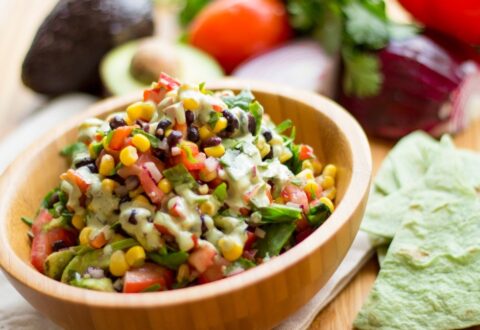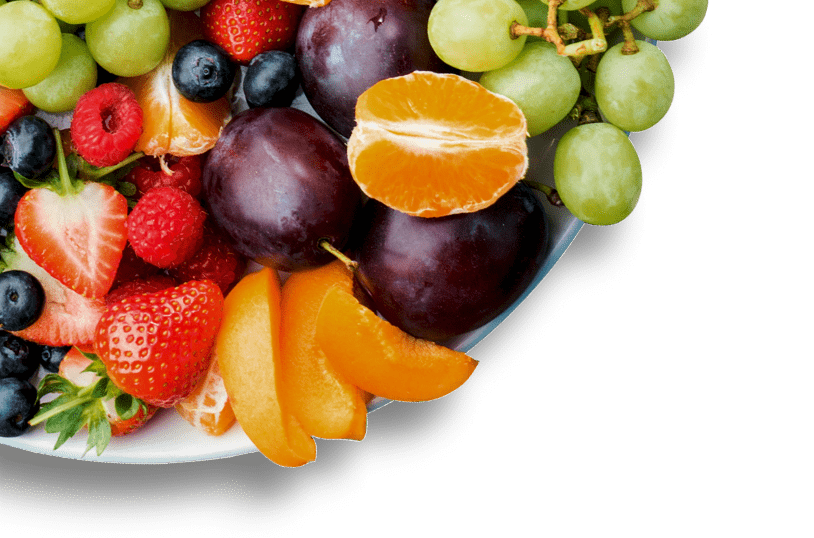Getting started guide
Your school can make a big difference when it comes to creating a healthy food and drink environment.

Why promote healthy eating?
Providing healthier foods and drinks at your school has the following benefits:
- can improve students’ mental health, concentration and academic performance
- helps student establish healthy eating habits during some of the most influential years of their life
- demonstrates to families that your school values the health and wellbeing of your students
- aligns with your school’s environmental sustainability efforts
- helps your school align with the Department of Education and Training Victoria’s Canteens, Healthy Eating and Other Food Services Policy, and the healthy
- eating benchmarks of the Achievement Program.
Key tip: If your school is creating a healthier food and drink environment we encourage you to register for Vic Kids Eat Well – an exciting state-wide movement that’s focused on transforming the food and drink environments where kids spend their time. Register here.
How to support healthy eating in schools
A school that is effectively providing and promoting healthier food and drinks will:
- provide food and drinks that meet the Canteens, Healthy Eating and Other Food Services Policy, including through the canteen, catering, fundraising, special events and vending
- promote and market only healthy food and drink options
- have a healthy eating policy and procedures in place to enable healthy changes to be sustained
- promote healthy eating in the classroom
- engage with families to support them in packing healthy lunchboxes and promoting healthy eating at home.
The Canteens, Healthy Eating and Other Food Services policy should be implemented as part of a whole-school approach to healthy eating.
This involves making healthy eating part of everyday school life by integrating it into planning and curriculum, developing a supportive culture and environment, and engaging the whole-school community.
A whole-school approach brings together school leadership (principal/s, school council), staff, food services, students, families and the broader community to promote healthy eating. Everyone has a role to play!
The steps below outline the suggested process you can follow to achieve this. However, it may not always be possible to work through them in this order.
You should aim to make progress where you can and in an order suitable to your school.
Step 1. Secure leadership commitment and engage key stakeholders
Having commitment from your principal, school council and other key stakeholders is an important first step. When leaders drive change, everyone in the school feels supported and motivated and changes can be sustained long-term.
It is also important to engage the whole school community to make healthy eating a part of everyday school life.
You can start making changes by:
- speaking to school leaders such as the principal, vice principal, school council or staff leadership teams:
- explain the importance and benefits of promoting healthy eating
- obtain their support for making healthy changes
- encourage them to take an active role in the change process
- working with school leaders to ensure there is adequate time, resourcing and support available for changes to take place
- be involved in a working group or health and wellbeing committee to create a plan and drive change. Ideally, the group will include someone from leadership, as well as other people in the school that support healthy eating, such as a school council representative, teachers, canteen staff, parents/carers and students
- developing a communications plan that details how you will inform students, staff and families about the school’s plans to ensure everyone is kept up to date. The plan should also include ideas to promote and celebrate the work you are doing towards providing and promoting healthy food and drinks
Factsheet: Whole of school approach
Step 2. Develop a healthy eating policy
Creating a healthy eating policy for your school will help to embed and sustain these changes.
You can have a specific healthy eating policy or make sure that healthy eating is included in other relevant policies, such as health and wellbeing, procurement and/or sustainability.
The policy should outline the school’s commitment to providing and promoting healthy foods and drinks in line with the Canteens, Healthy Eating and Other Food Services Policy in all areas of the school, such as:
- canteen and other food supply
- curriculum activities and learning opportunities
- snack and drink breaks
- lunchboxes
- breakfast programs
- camps and excursions
- sports days
- fundraisers and events
- sponsorship
- awards and acknowledgements
- engaging with families and the wider community.
An effective policy must be clear and communicated regularly to the whole school community. Review and update the policy every one to two years to ensure it remains relevant and appropriate.
Template: Creating a healthy eating policy
Step 3. Engage canteen and other food services
Engaging canteen staff and/or school food services is an important step in making changes to the meals, snacks and drinks on offer.
Creating a realistic plan that involves school food services and takes into consideration their concerns, barriers and priorities assists with successful implementation.
This applies to the canteen manager and staff or volunteers, as well as anyone supplying foods and drinks to your school, such as contracted food services, external businesses and retail food outlets supplying schools (e.g. milk bars, cafes and bakeries) vending machine and school breakfast programs.
It is important to discuss the following points with the food service providers:
- the requirements of the Canteens, Healthy Eating and Other Food Services Policy. This includes offering mostly Everyday foods and drinks, no confectionery or sugar sweetened beverages, and Occasionally items only twice a term (see examples: Canteens, Healthy Eating and Other Food Services: Everyday, Select Carefully and Occasionally food categories | education.vic.gov.au)
- how to assess their current menus and find healthier Everyday and Select Carefully items using FoodChecker
- HEAS services, including information on healthy recipes and food and drink ideas
- how to price and promote healthier foods and drinks
You should also encourage food service staff and managers to complete our free online training.
Step 4. Recommend online training
Free online training is recommended for anyone involved in providing foods and drinks in Victorian primary and secondary schools, including canteen staff and volunteers, external food suppliers, principals, teachers and parents/carers.
Through our online module you will gain essential knowledge and skills to provide healthier options in line with the Canteens, Healthy Eating and Other Food Services Policy and learn how to price and promote healthy options for success!
You can do the training online – anywhere, anytime. It takes less than one hour and you will receive a certificate of completion.
Training: Healthy school food services
You can use our free online assessment tool, FoodChecker, to assess the canteen menu and/or other food services to find out if the foods and drinks provided are classified as Everyday, Select Carefully or Occasionally according to the Canteens, Healthy Eating and Other Food Services Policy.
You can use FoodChecker to:
- assess your current menu and get recommendations for healthy changes
- plan a new menu that meets the policy
- assess individual recipes and products
- find Everyday and Select Carefully products
You will receive instant feedback on the foods and drinks provided and tailored recommendations for healthier changes.
Step 6. Making changes
The following steps can be done at the same time, or separately and in any order.
Make healthy changes in your canteen or food service
Work with the relevant team members to decide on simple changes that will have a big impact.
There are many ways to introduce these changes – you can do it all at once or introduce them gradually. You can also start with specific areas, such as drinks.
No matter your starting point, you should prioritise the following goals:
- remove all sugar-sweetened beverages and confectionary
- remove all Occasionally items (these should be offered no more than twice a term)
- provide at least 50% Everyday items on your menu
Gain inspiration from the changes other schools have made
Embed healthy eating requirements in contracts and tenders
Your school may have contracts or lease agreements with a variety of food suppliers including canteen or food service providers, distributors, caterers and/or vending machine suppliers.
- Including requirements in contracts or tenders for food suppliers to provide healthy foods and drinks in line with the Canteens, Healthy Eating and Other Food Services Policy will embed these changes in your school longer term. This establishes clear expectations about the types of foods and drinks your school does and does not want made available.
It also:
- ensures food service providers are contributing to students’ health and wellbeing
- empowers food service providers that want to make healthy changes
- facilitates market demand for healthier food and drink products
- demonstrates your school’s commitment to promoting healthy lifestyles
- reinforces nutrition and healthy eating messages in the curriculum
Your school may also consider joining with other local schools to enable larger orders from healthier suppliers.
Key resource: Template: Example food provision contract
Host healthy events and fundraising
You can reinforce healthy eating messages by making sure that nutritious options are available at school events, like birthdays, fundraisers, school fetes and other celebrations.
This can include choosing healthier alternatives to chocolate fundraising, offering healthier options at barbecues and celebrating cultural events with nutritious food.
Foods and drinks in the Occasionally category are allowed in schools up to twice per term, as they are low in nutritional value and high in energy, saturated fat, sugar and/or salt.
Confectionery, lollies and soft drinks should not be supplied in schools at any time, according to the Canteens, Healthy Eating and Other Food Services Policy.
Promoting healthy eating in the classroom
Healthy foods and drinks should be promoted to students throughout the school, including in the classroom and with families.
When students eat well, they are more likely to perform better and have better mental health outcomes.
Teachers can promote healthy eating by:
- teaching healthy eating curriculum content using reputable teaching resources
- connecting school garden programs to healthy eating and the canteen
incorporating healthy foods in other curriculum areas (such as combining the history of cuisine and agriculture with lessons about art, maths, psychology and science) - connecting curriculum activities to the canteen
- not using chocolates or lollies as rewards or incentives
- engaging and educating parents/carers to support healthy eating at home for consistent healthy eating messaging.
Step 6. Celebrate success
Sharing your progress with the school community is a great way to celebrate your success.
You could use the school newsletter, website, social media and assemblies to inform staff, students and families about the progress you have made, announce new menu items, upcoming special events, or to celebrate your achievements.
You could also celebrate the changes you have made by holding a special event at the canteen.
When communicating your changes and celebrating your success to the school community, be sure to use positive language and tone.
You can do this by:
- focusing on what you’ve added rather than what you’ve reduced or taken away
- talk about the broader benefits of providing more nutritious foods, such as optimal growth, development, positive impact on mood, concentration and learning, rather than talking about food in relation to weight or disease risk.
- use fun and engaging names for new menu items or events, for examples ‘zesty summer salad roll’ for a roll at the canteen, or ‘super smoothie day’ for an upcoming fundraising event.
Step 7. Maintaining changes
Maintain your progress by:
- ensuring a healthy eating policy is in place, communicated, promoted and reviewed every one to two years
- assessing any new menus or menu changes as they occur through FoodChecker
- reassessing the canteen menu (or other foods and drinks) every one to two years to ensure it still meets the policy (tip: including in your policies and procedures a clause requiring regular menu assessments will help to ensure that they happen)
- ensuring contracts with food service providers require compliance with your healthy eating policy
- ensuring all new canteen staff and volunteers complete training as part of their induction
- ensuring you are taking a ‘whole of school’ approach by involving all members of the school community
- seeking feedback from staff, students and families to identify any issues and make sure you are on track to achieve your goals
- continuing to promote your achievements and share updates to your menu with families, so they know when to expect changes.
Supporting you in making healthy changes
The Healthy Eating Advisory Service is here to support your service. If you’d like assistance in any of the above steps please contact our dedicated Nutrition Policy Advisor:
Infoline: 1300 22 52 88
Email: heas@nutritionaustralia.org.au
For more information please phone 1300 22 52 88 or email heas@nnf.org.au
Except where otherwise indicated, the images in this document show models and illustrative settings only, and do not necessarily depict actual services, facilities or recipients of services. This document may contain images of deceased Aboriginal and Torres Strait Islander peoples. In this document, ‘Aboriginal’ refers to both Aboriginal and Torres Strait Islander people. ‘Indigenous’ or ‘Koori/Koorie’ is retained when part of the title of a report, program or quotation. Copyright © State of Victoria 2016
Written and reviewed by dietitians and nutritionists at National Nutrition Foundation, with support from the Victorian Government.

Related resources
Featured recipes
Explore more recipesRegister your interest
"*" indicates required fields

















